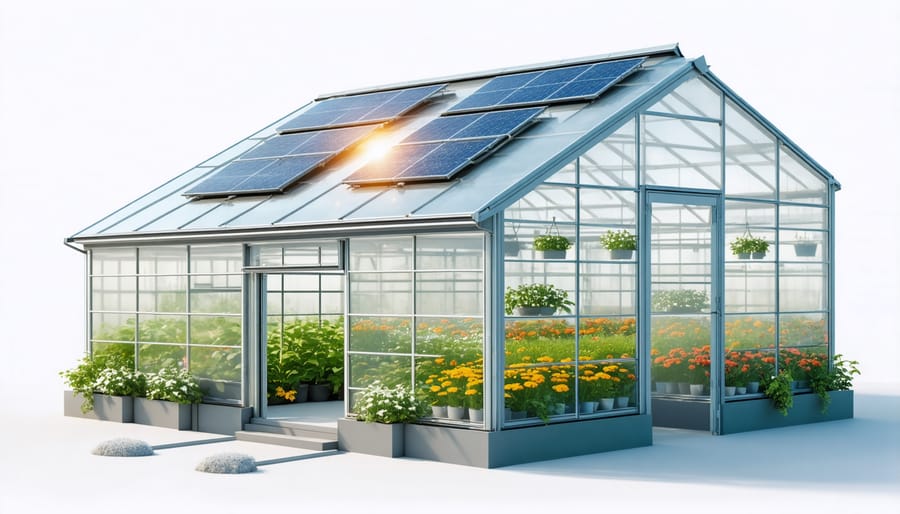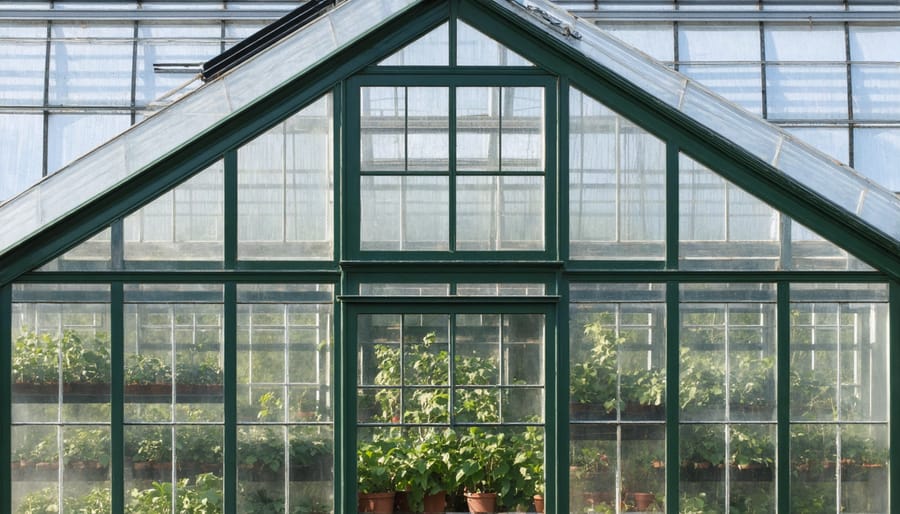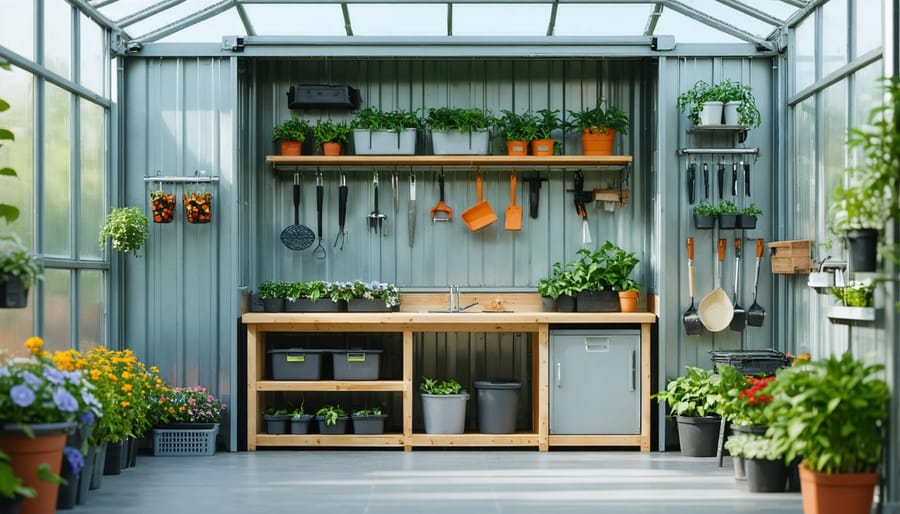Build Your Dream Greenhouse Shed: Smart Design That Saves Money and the Planet

Transform your backyard into a versatile growing and storage space by combining energy-efficient shed designs with greenhouse functionality. Position your greenhouse shed to capture maximum sunlight during winter months, typically facing south or southeast in North America. Install dual-pane polycarbonate panels on the growing side to trap heat while maintaining traditional weather-resistant siding on the storage portion. Integrate adjustable vents and thermal mass storage using water barrels or concrete floors to regulate temperature naturally.
Create distinct zones within the structure: dedicate 60% to growing space with raised beds and vertical gardening systems, while reserving 40% for organized tool storage and potting stations. Maximize efficiency by installing solar-powered fans, automated watering systems, and LED grow lights powered by roof-mounted panels. This hybrid approach delivers year-round growing capability while providing essential storage space, perfect for urban homesteaders and serious gardeners seeking sustainable solutions.
The thoughtful combination of growing space and storage area not only optimizes your property’s footprint but also extends your growing season while protecting valuable tools and supplies from the elements.
Smart Planning for Your Eco-Friendly Greenhouse Shed
Location and Solar Orientation
Selecting the perfect location for your greenhouse shed can dramatically transform your backyard space while maximizing growing potential. The ideal spot receives 6-8 hours of direct sunlight daily, with the longest side facing south in the Northern Hemisphere. This orientation captures maximum sunlight during winter months when it’s needed most.
Consider natural windbreaks like trees or fences to protect your structure, but ensure they’re far enough away to avoid casting shadows. A slight east-facing tilt can be beneficial, as morning sun helps plants warm up gradually and dry any overnight condensation.
The ground should be level and well-draining to prevent water pooling around the foundation. If possible, position your greenhouse shed within easy reach of utilities like water and electricity. Remember to check local building codes and setback requirements before finalizing your location.
A smart tip is to observe your chosen spot throughout different seasons. Take note of shadows cast by nearby structures and how wind patterns affect the area. This careful planning ensures your greenhouse shed will serve you effectively year-round.

Size and Space Optimization
Finding the perfect balance between growing space and storage needs is crucial when designing your greenhouse shed. A good rule of thumb is to allocate 60% of the space for growing and 40% for storage, though this can be adjusted based on your specific needs.
For most home gardeners, an 8×12 foot structure provides ample room for both purposes. This size allows for growing areas along the walls and a central walkway that doubles as storage access. Consider vertical space too – installing adjustable shelving units can maximize your growing area while maintaining storage underneath.
When planning dimensions, factor in workspace clearance. Allow at least 3 feet of walkway width for comfortable movement with gardening tools and storage bins. Height is equally important – a minimum interior height of 7 feet provides enough headroom for tall plants and hanging storage solutions.
For smaller yards, consider L-shaped designs that tuck neatly into corners while maintaining separate zones for plants and tools. Remember to include space for essential features like potting benches and water storage, which serve both growing and maintenance purposes.
Sustainable Materials That Last
Recycled and Reclaimed Options
Building an eco-friendly greenhouse shed doesn’t mean compromising on quality or aesthetics. By incorporating sustainable building practices, you can create a beautiful and functional space while reducing your environmental impact.
Reclaimed wood is an excellent choice for your greenhouse shed’s framework and shelving. Look for salvaged lumber from old barns, demolished buildings, or local restoration projects. These materials often come with unique character and patina that new wood simply can’t match. Just ensure the wood is properly treated and structurally sound before use.
Recycled plastic lumber offers another durable option for your greenhouse shed’s base and structural elements. This material resists rot, insects, and moisture while giving plastic waste a second life. It’s particularly useful for areas that come in contact with soil or water.
Windows are perhaps the most crucial element of a greenhouse shed, and salvaged windows can be a goldmine. Check architectural salvage yards, renovation sites, or online marketplaces for old windows in good condition. Clean them thoroughly and replace any broken seals to ensure proper insulation. Many gardeners find that vintage windows add charm while serving their practical purpose.
Consider using recycled metal sheets for portions of the roofing or incorporating reclaimed brick or stone for the foundation. These materials not only reduce waste but often cost less than new materials while adding character to your structure.

Energy-Efficient Glazing Choices
Choosing the right glazing for your greenhouse shed is crucial for maintaining optimal growing conditions while keeping energy costs down. Double-paned glass panels are an excellent investment, offering superior insulation compared to single-pane options. These panels create an air pocket that helps regulate temperature and reduces heat loss during colder months.
For a more budget-friendly alternative, consider polycarbonate panels. These lightweight, durable sheets provide excellent insulation and diffuse sunlight evenly across your plants. Twin-wall or triple-wall polycarbonate options offer enhanced thermal efficiency and can save up to 30% on heating costs compared to traditional glass.
Low-E (low emissivity) glass is worth considering for climate-controlled greenhouse sheds. This specialized coating reflects heat back into your growing space during winter while keeping it cooler in summer. While it’s a pricier option upfront, the long-term energy savings make it a smart choice for year-round growing.
For maximum efficiency, consider installing adjustable ventilation panels alongside your chosen glazing. This combination allows you to control temperature and humidity levels naturally, reducing the need for artificial heating and cooling. Remember to seal all joints and edges properly to prevent heat loss and maintain the efficiency of your chosen glazing material.
When selecting your glazing, factor in your local climate and the types of plants you’ll be growing. Southern exposures might benefit from light-diffusing panels, while northern locations may need maximum light transmission.
Smart Climate Control Features
Passive Ventilation Systems
A well-designed passive ventilation system is essential for maintaining the perfect growing environment in your greenhouse shed. Natural airflow helps regulate temperature, control humidity, and strengthen your plants without relying on electrical systems.
The key to effective passive ventilation lies in strategic placement of vents and windows. Install low-level vents near the base of your greenhouse shed and higher vents or windows near the roof peak. This creates a natural chimney effect, as warm air rises and escapes through the top while drawing cooler air in through the bottom vents.
For optimal air circulation, position your greenhouse shed to take advantage of prevailing winds. Adding adjustable side vents allows you to fine-tune airflow based on weather conditions and seasonal changes. Consider installing automatic vent openers that respond to temperature changes – they’re incredibly convenient and don’t require electricity.
Ridge vents running along the roof’s peak provide consistent air movement and help prevent overheating during summer months. Complement these with louvered windows that can be adjusted throughout the day to maintain ideal growing conditions.
Don’t forget about door ventilation – a Dutch door design lets you open the top half for additional airflow while keeping the bottom closed for security. For humid climates, adding a solar-powered fan can supplement your passive system during particularly muggy days.
Water Conservation Methods
Water conservation is a crucial aspect of any sustainable greenhouse shed design, and implementing smart water management solutions can significantly reduce your environmental impact while keeping your plants thriving. One of the most effective methods is installing a rainwater harvesting system, which can collect and store rainfall from your shed’s roof for later use.
Consider installing gutters along your greenhouse shed’s roofline that connect to water barrels or tanks. These containers can store hundreds of gallons of water, providing a reliable source during dry spells. For maximum efficiency, position your storage tanks slightly elevated to create natural water pressure for irrigation.
Efficient irrigation methods like drip systems or soaker hoses deliver water directly to plant roots, minimizing waste through evaporation. These systems can be connected to timers, ensuring your plants receive consistent moisture without overwatering. Installing a moisture sensor can help automate the process, activating irrigation only when necessary.
Layer your planting beds with organic mulch to retain soil moisture and reduce watering frequency. Consider incorporating a gray water system to reuse household water for your greenhouse plants when appropriate. For smaller setups, self-watering containers and wicking beds can provide consistent moisture while using less water.
Remember to regularly maintain and clean your water collection system, checking for leaks and ensuring gutters remain clear of debris. These simple yet effective water conservation methods will help create an environmentally responsible greenhouse shed that’s both productive and sustainable.
Storage Solutions That Work

Vertical Storage Systems
Maximizing vertical space in your greenhouse shed is essential for maintaining an organized and efficient growing environment. By implementing smart storage solutions, you can keep your tools and supplies easily accessible while preserving valuable floor space for your plants.
Start by installing adjustable wall-mounted shelving systems that can be modified as your storage needs change. Heavy-duty pegboards are perfect for hanging frequently used tools like pruners, trowels, and watering cans. Consider using clear plastic holders or wooden tool organizers to keep everything visible and within reach.
Make the most of your wall height by incorporating stackable storage bins on sturdy brackets. These are ideal for storing potting soil, fertilizers, and seasonal items. Label everything clearly to maintain organization and efficiency. Installing a vertical garden tool rack keeps longer items like rakes and shovels neatly arranged and prevents them from falling over.
Don’t forget about the back of your greenhouse shed door – it’s prime real estate for additional storage. Over-the-door organizers with clear pockets are perfect for storing seed packets, plant labels, and small garden accessories. For frequently used items, magnetic strips mounted at eye level can hold metal tools and create an easily accessible mini toolstation.
Remember to position your vertical storage systems strategically to avoid casting shadows on your plants. Keep heavier items at waist height or lower for safety, and ensure all mounted systems are properly secured to support their intended weight. With thoughtful vertical organization, you’ll create a more productive and enjoyable greenhouse environment.
Multi-Purpose Work Areas
A well-designed greenhouse shed needs versatile work areas that can adapt to different tasks throughout the growing season. The key is to create zones that serve multiple purposes while maintaining an organized flow. Start by incorporating a sturdy potting bench that can double as a workspace for seedling preparation and general maintenance tasks. Choose weather-resistant materials like cedar or treated lumber for longevity.
Consider installing adjustable shelving units along the walls that can accommodate both storage containers and temporary plant staging. These shelves should be strong enough to hold heavy pots and tools but can be easily modified as your needs change. Include a mix of open and closed storage solutions – weather-tight bins for protecting sensitive materials and open baskets for frequently used items.
A fold-down workbench can be a game-changer in smaller spaces, providing an extra surface when needed while freeing up valuable floor space when not in use. Install pegboards or tool organizers above work areas to keep essential items within arm’s reach without cluttering your workspace.
Don’t forget to incorporate a dedicated cleanup station with a small sink if plumbing is available, or at least a water barrel with a spigot for hand-washing and plant maintenance. Having a designated space for cleaning tools and pots will help maintain organization and prevent cross-contamination between plants.
Create zones for different activities: one area for potting and transplanting, another for tool storage and maintenance, and a third for storing seasonal items like spare pots, trays, and growing media. This systematic approach helps maintain efficiency and makes the most of available space while keeping everything accessible when needed.
Designing and building your own greenhouse shed is an exciting project that combines the best of both worlds – a practical storage space and a nurturing environment for your plants. By following the guidelines we’ve discussed, you can create a structure that serves multiple purposes while maintaining efficiency and style. Remember to carefully consider factors like orientation, ventilation, and material choices to ensure your greenhouse shed performs optimally throughout the year.
Whether you’re an experienced gardener looking to expand your growing space or a DIY enthusiast eager to tackle a rewarding project, a greenhouse shed offers the perfect solution. The dual functionality not only maximizes your available space but also provides year-round benefits for both storage and cultivation needs.
Start by creating a detailed plan that incorporates all the essential elements we’ve covered, from proper insulation to strategic shelving placement. Don’t forget to check local building codes and obtain necessary permits before beginning construction. Take your time with the foundation and framework, as these elements are crucial for long-term stability and success.
As you embark on your greenhouse shed project, remember that customization is key. Adapt the design to suit your specific needs while maintaining the core principles of effective greenhouse and storage design. With proper planning and execution, your greenhouse shed will become a valuable addition to your property, providing years of functionality and enjoyment for both gardening and storage purposes.

